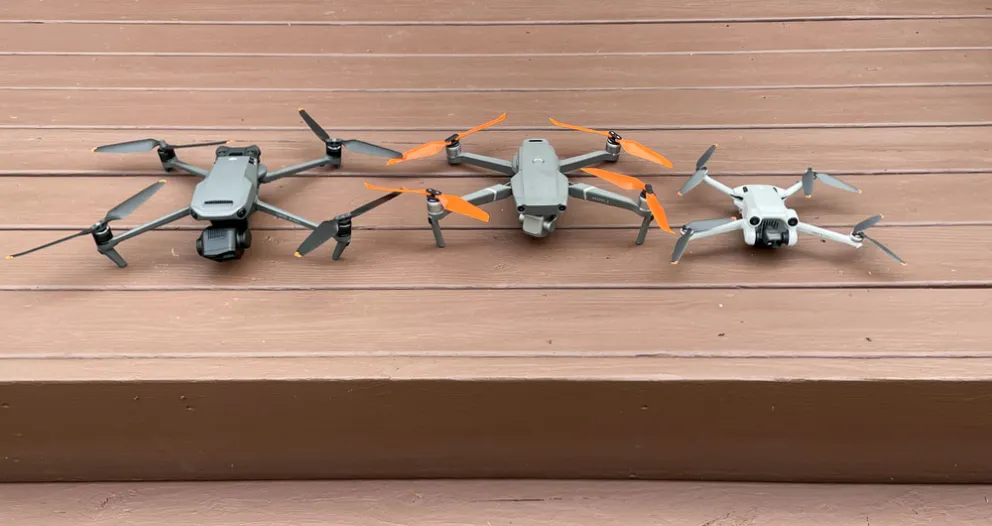
UPAA Blog 2023-24 #2 - 9/21/23 - Text and photos by Matt Cashore
This is the first in a series of articles on drones.
The era of consumer drones arguably began in 2013 with the the first DJI Phantom. In only 10 years drone tech and regulations have evolved and continue to evolve at a remarkable pace. These articles will take a look at some of the new tech and new opportunities available to drone pilots today. In the photo above, from left to right: The DJI Mavic 3 Pro, DJI Mavic 2 and Diji Mini 3 Pro. -Ed
In the Spring of 2023 I was briefly the owner of three DJI drones - a Mavic 3 Pro, a Mavic 2 and a Mini 3 Pro. I love side-by-side comparisons, so of course I was going to do one while I had all three drones. Here's an unscientific, utterly subjective opinion on three of the options that most UPAA members would likely have if you're purchasing or upgrading drones.
But before that, a quick aside on the legalities of drone flying.
I've been a general aviation pilot for 25 years. Multiple written tests, multiple checkrides, and LOT of saying "Niner" and "Roger." I'm more familiar with FAA language, rules, airspace, etc. than most and even I feel like I can't keep up when it comes to drone rules. In less than a decade, Part 107 licensing was implemented, LAANC was quickly introduced and implemented, remote ID was quickly introduced...and then delayed. There have been changes to the rules about flying over people and flying at night. Even then, different rules might apply if you're flying for yourself or flying for your job...and add to all of that the various policies and protocols your institutions may have. (Whether or not they exceed actual laws doesn't really matter, we all want to work well with our campus safety and security operations.) So that's the wordy version of saying: It's confusing and ever-changing. Do the best you can and use your common sense.

Back on topic... I was very happy with my Mavic 2. Outstanding tool. The image quality was surprisingly good. Occasionally I'd see a poster or large print of a Mavic 2 image and it always exceeded my expecations for small-sensor image quality. The ability to hover and look straight-down was a fun new creative option.

Drone tech changes even faster than drone rules, and a brief experience with the DJI Mini 3 Pro made me realize the benefits of the newer DJI remote controller and software. The Mavic 3 Pro used the same controller. That, plus it's three lenses and a slightly larger sensor was enough to get me to make the switch. (I got mine from Roberts.) But how was the image quality compared to the Mavic 2? Only one way to find out:
The Contestants

Mavic 2

Mavic 3 Pro



Mini 3 Pro:

Now it's time to get pixel-peepy! Here are zoomed-in details from the center of the main camera of each drone. The results may surprise you, they certainly did me!
Mavic 2

Mavic 3 Pro

Mini 3 Pro

The verdict? From the main camera image quality test I did here, I still like the Mavic 2 the best, and the Mini 3 is astonishingly good for how small and cheap it is. Do I regret selling my Mavic 2 for the Mavic 3? No. The image quality is close enough, and the Mavic 3 brings enough new features to the table--more battery life, USB-C charging, a better remote and 3 focal length options--that it's a worthwhile upgrade.

New toys are fun, but the bosses and accountants want to know how it's going to help us do our jobs better. Sure, here you go...


The bottom line here is that you really can't make a bad choice on a DJI consumer drone. For around $2500, get the most flexibilty with the Mavic 3 Pro. For just over $1000, get the current Mavic 2 equivalent in the Mavic Air2S. (Or find a nice used Mavic 2.) And for under $1000 the Mini 3 Pro does a surprisingly good job in the most portable form factor.
Next up in the drone series is an article on navigating the world of stadium TFRs.
"The bank rejected my application for a loan to start a drone pizza delivery business. Said the idea was too pie-in-the-sky." Thanks for reading the UPAA Blog. Submissions and suggestions are welcomed and encouraged. Contact editor Matt Cashore, mcashore@nd.edu. And if you don't already, be sure to follow UPAA on Instagram!